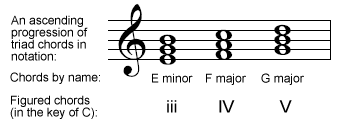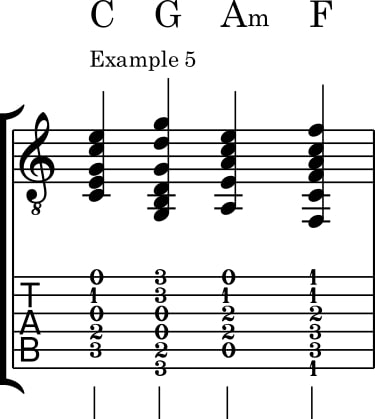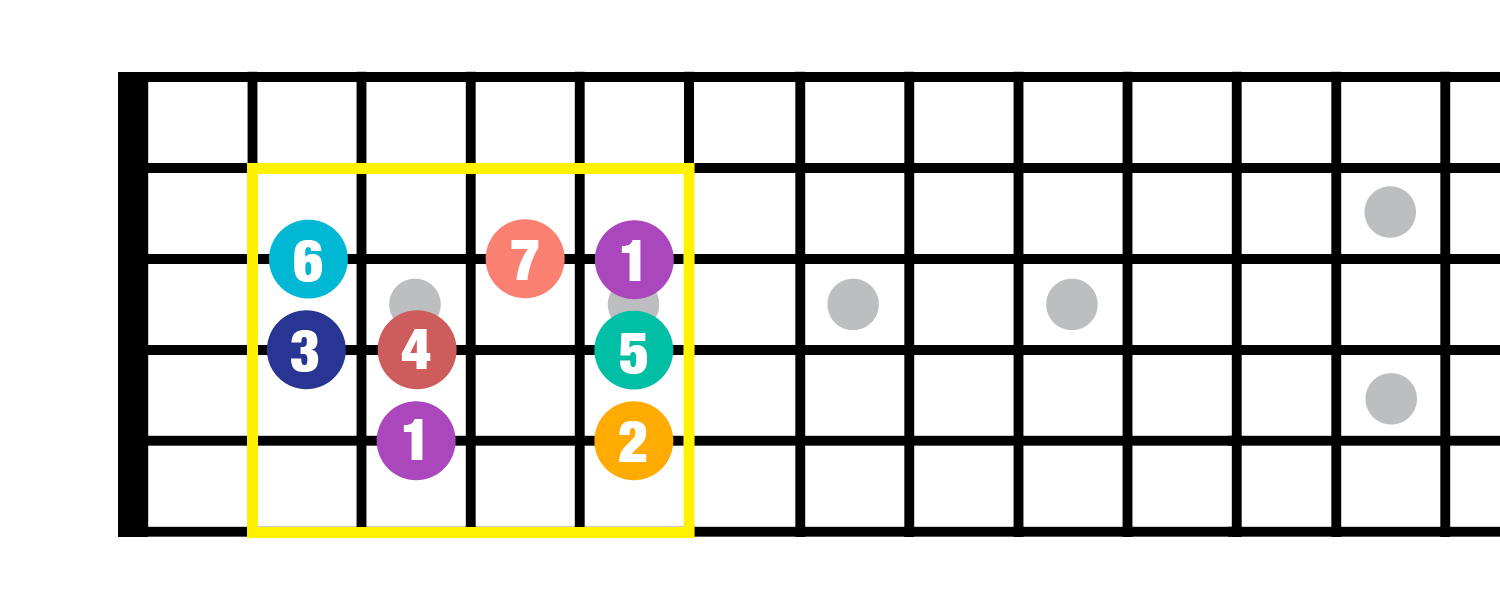Another example is I IV V IV which allows us to play songs like "Louie Louie" by Richard Berry and "Wild Thing" by The Troggs An example that uses the simple I IV V progression is the entirety of "Stir it Up" by Bob Marley We cover how to play this chord progression for the verse of " Good Riddance" by Green DayThe 12bar blues is one of the most popular chord progressions in popular music, including the blues The blues progression has a distinctive form in chord structure and duration It is, at its most basic, based on the IIVV chords of a key The 12 bar blues progression is the foundation of the bluesThe 12bar blues is one of the most popular chord progressions in popular music, including the blues The blues progression has a distinctive form in chord structure and duration It is, at its most basic, based on the IIVV chords of a key The 12 bar blues progression is the foundation of the blues
What Are Some Pleasing Chord Progressions Besides I V Vi Iv Quora
I iv v chord progression guitar
I iv v chord progression guitar-The end goal is to ingrain this movement in a harmonic as well as a linear fashion Direct movement vs Temporary modulation When we talk about the relationship between the I and IV chord, we don't just mean moving diatonically from the I chord to the IV chord in a single key As an improviser, you'll also encounter this relationship in tunes that begin in the tonic and over the courseSo IIVV is so important because this is the ultimate way to maximize the 'majorness' of a chord progression In that it is the only way within a key to write a 3 chord progression containing


Borrowed Chords How To Spot Play Over Them
If you check our chord chart, the I – IV – V – I progression would look like this If you are working on a song, you can try this simple progression and work on your melody It's a good starting point and builds on it as you progress If you noticed, these are also all major triads, and no minor chords are involvedThe 2 other chords that act as big signposts pointing to this "home" chord are the IV chord (called the sub dominant) and the V chord (called the dominant) The V chord resolves to the I chordBy looking at Figures 5 and 6, you should be able to tell that a IV progression consists of two chords, built upon the root note and the perfect fifth, respectively In other words, this IV indicates that the progression starts with a G major chord followed by a D major chord The famous IIVV
Chords in the I IV V I Progression page 2/3 Music Theory Chord Progressions In it's most simple definition, a Chord Progression is ANY chord that moves to ANY other chord But, when we talk about chord progressions, we are usually speaking about those progressions which have been used time and time again to the point we recognize them to beThe I IV V chords are therefore F major, major and C major You can do this with any key as long as you know the notes of the major scale The major scale is easy to form All you do is use the formula, whole step, whole step, half step, whole step, whole step, whole step, half stepExample of Chord Progressions focusing on the I – IV – V Example of Chord Progression in C Major As you can see I have chosen to use the 3 strong chords (I, IV, V) the most, and only added VIchord (Am) and IIchord (Dm) once each to create some variation C – G – F – C – Am – G – C – G – Dm – C – G – C
The blues progression has a distinctive form in chord structure and duration It is, at its most basic, based on the IIVV chords of a key The 12 bar blues progression is the foundation of the blues The whole blues genre is very minimalistic There are two common variations of the 12 bar blues progressionThe I IV V progression is the most common of all chord progressions It is used in heaps of songs, either as the complete progressions or as a part of it The I IV V is sooner or later prolonged to I IV V I which include the "home chord" since the V built tension that wants to resolved in the I chordClick on this image below to download the FREE PDF song that goes along with this video Please feel free to print this out, copy this, and share it with your piano students (if you are a piano teacher), or with family and friends who may be excited and interested in learning How to Play a IIVVV7 Chord Progression and What to Do With It This PDF is free and I encourage everyone to learn



The I Iv V Chord Family



Chord Progression Wikipedia
Even if you haven't heard of the IIVV chord progression before from a theory standpoint, you have no doubt heard countless famous songs that use these three chords Here is a list of 10 IIVV songs to get you started with this applying this chord progression to the fretboard 1 Should I Stay or Should I Go The Clash 2So IIVV is so important because this is the ultimate way to maximize the 'majorness' of a chord progression In that it is the only way within a key to write a 3 chord progression containingThe IIVV Progression Whereas the IviIVV7 Rock Ballad (DooWop) Progression substituted the harder sounding "IV" chord for the softer "ii" chord of the IviiiV7 Standard Changes, the Rock Progression also omitted the softer sounding "vi" chord to create an even harder rock sound Examples of the classic IIVV Rock Progression include La Bamba verse (1959), Time Is On My



24 Guitar Chord Progression You Must Learn Common Rock Sad Jazz Rock Guitar Universe



Music Composition For Beginners 3 The I Iv V Chord Progression Guitar Com All Things Guitar
Example of Chord Progressions focusing on the I – IV – V Example of Chord Progression in C Major As you can see I have chosen to use the 3 strong chords (I, IV, V) the most, and only added VIchord (Am) and IIchord (Dm) once each to create some variation C – G – F – C – Am – G – C – G – Dm – C – G – CExamples of the classic IIVV Rock Progression include La Bamba verse (1959), Time Is On My Side chorus (1964), Like A Rolling Stone chorus (1965), Come And Get It verse (1970), Guitar Man verse (1972), Born To Run verse (1975), Rock And Roll All Nite chorus (1976), Two Tickets To Paradise) chorus (1978), The River Of Dreams verse (1993), Mr Jones chorus (1993), and I'll Be There For You chorus (1995)Once you've found the G chord, practice moving between IV and V When you're feeling comfortable with each shape, try moving through the progression using whole notes (4 beats each) C Major (I), F Major (IV), G Major (V), and back to C Major (I) IIVV With the Left Hand And what about the left hand?



Ukulele Chords In Common Keys I Iv V Ukulele Ukulele Chords Ukulele Chords Chart



How To Write Chord Progressions On Guitar 10 Beautiful Examples Fingerstyle Guitar Lessons
So IIVV is so important because this is the ultimate way to maximize the 'majorness' of a chord progression In that it is the only way within a key to write a 3 chord progression containingCheck it out in the video above These are just 3 examples of this common chord progression in popular music Trust me, there are countless!The I, IV, V chord progression is one of the most recognizable chord progressions in modern music It's roots go back to early blues music and continues to thrive today across multiple genres It is first important to understand that a common way for musicians to refer to any chord progression is through the use of numbers



Sofmi Chord Progression Excercise Handout Sofmi Chord Progression In This Studocu



Chord Progressions Writing Hit Songs Made Easy
Click on this image below to download the FREE PDF song that goes along with this video Please feel free to print this out, copy this, and share it with your piano students (if you are a piano teacher), or with family and friends who may be excited and interested in learning How to Play a IIVVV7 Chord Progression and What to Do With It This PDF is free and I encourage everyone to learnThe I IV V chords are used because they can harmonize with every other note in that scale A standard major chord progression will always be I IV V , or in this case, C major, F major and G major chords In the video below, the Jamplay guitarIIVV Progressions – The Essential Chords of Pop If you want to groove, but don't know where to start, look no further The IIVV progression is one of the most common chord progressions in music In fact, if you have ever listened to pop or to the blues, chances are you have heard this progression at work



2 Finger Mandolin Chords For 1 4 5 Progression Mandolin Ukulele Chords Mandolin Lessons


Popular Piano Chord Progressions



0 件のコメント:
コメントを投稿